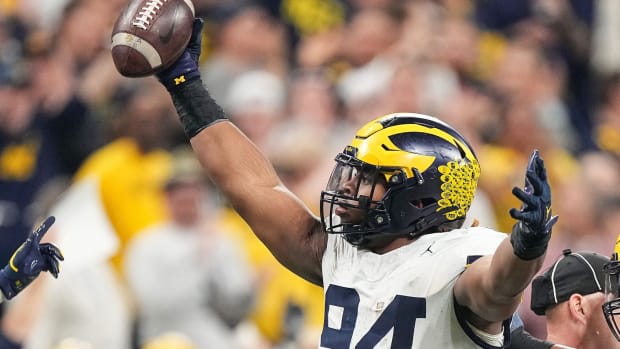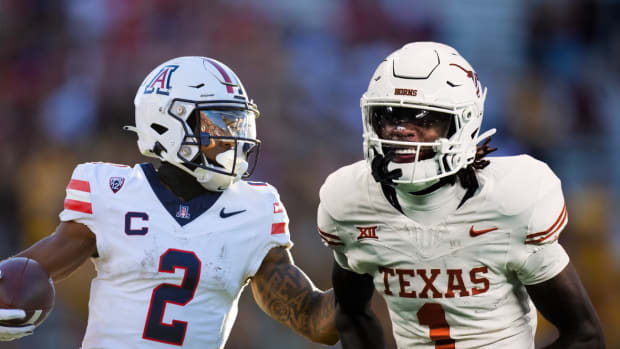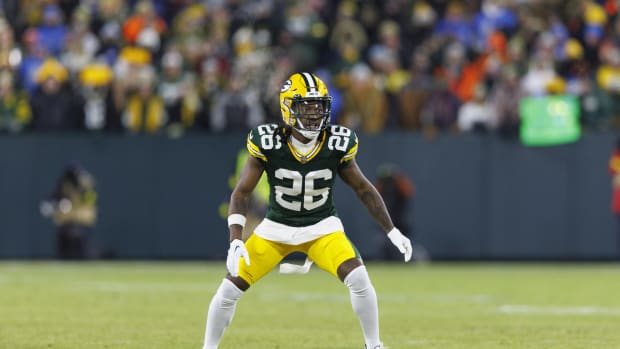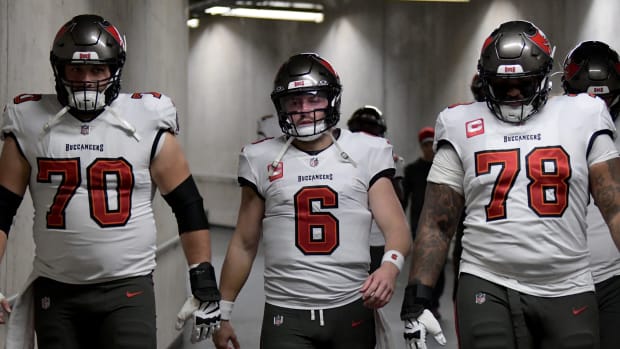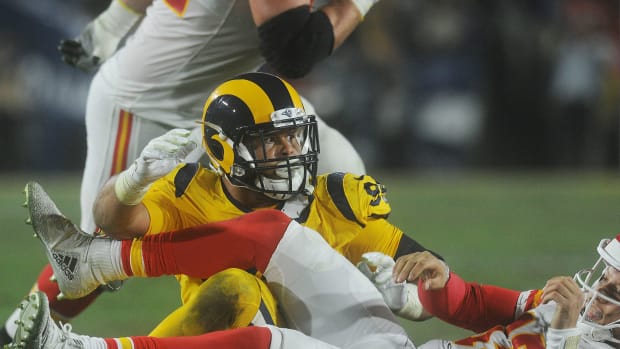The NFL Draft Debate on the Great Aaron Donald
NFL free agency is basically in the rear-view mirror, the owners meetings are next week and the draft is only a few weeks away. No rest for the weary …
• Because he may be the single most-dominant player of the past decade, I don’t mind doubling down on Aaron Donald content (our takeaways led with him, too). And we’ll start by turning the clock back to 2014, when the undersized Pitt defensive tackle was, to some degree, a polarizing prospect among scouts.
Everyone knew he could play. From there, two questions remained. One was whether he’d be a scheme-specific player—needing to be in a system that would get him upfield, and not require him to take on blocks, given his lack of height (6’1"), weight (280 pounds) and length. Another was whether he’d be able to handle the down-to-down rigors of being an NFL defensive lineman.
That debate wasn’t limited to teams that were skeptical. It’s one, according to several people who were there, that was spirited in the Los Angeles Rams’ draft meetings.
Then-coach Jeff Fisher was one who really liked Donald. In those meetings, he used a guy he coached, former Eagles star Jerome Brown, as an example of a shorter, lighter guy who became dominant at the position. Warren Sapp was another guy he raised to emphasize that height and length weren’t the end-all, be-all for defensive linemen.
But it was Ray Agnew, a former first-round defensive lineman who was getting his start in scouting after serving as director of player development and team chaplain, who emerged over that time as the team’s Aaron Donald evangelist. He, college scouting director Brad Holmes (now Lions GM) and senior scout Rich Snead had taken a liking to Donald, and were on Fisher’s side with pushback coming from other corners of the room.
The normally reserved Agnew, I’m told, literally slammed his hands on the table during a Donald debate, insisting that the Pitt prospect was fully capable of being a full-time player in any scheme. And because of his playing experience, and the respect everyone in the building had for Agnew, his emotion on Donald carried real weight.
When I asked Fisher about that debate, he told me, “Ray was so soft-spoken. And he’d come down and tell me, Hey, he’s really good. I said, I know he’s really good. He’s going to be a good player.”
Maybe no one knew just how good.
But Agnew, now the Lions’ assistant GM, had a better idea than most.
• From there, Donald’s second (and final) head coach Sean McVay had a pretty good idea of the future Hall of Famer’s talent when he took over the Rams in 2017. But, he’ll admit now there was no way he could know just how good Donald would get until he actually saw him day to day, and that’s the first thing McVay mentioned when I asked him what he thinks Donald has that no other player does.
“I think the number one trait he has is this mental toughness and this competitiveness internally, this intrinsic motivation,” McVay says. “I saw a documentary a few years ago. It’s called In Search of Greatness. It has a bunch of people that did a bunch of historical data and evidence on all these greats in a bunch of different sports arenas. They said there were two things that were common amongst all these people—there was a rage to master, and there was an ability to pick things up quickly in their domain.
“I don’t know if I’ve ever been around a more driven player that stayed humble through the success, that had higher standards than he did of himself from a preparation standpoint, and then an ability to be accountable in his game. He’s so unique with his mental makeup, his upbringing. Then, he has this natural strength, leverage, explosiveness, get off. He has the most accurate hands I’ve ever seen.
“That’s the one thing that I think people don’t talk about enough is he never missed with his hands. He’d always get those inside positions. His ability to break down offensive linemen and understand the nuances of how their game shifts and alters through the different situations that arise during the course of a game, it’s unique. When you ask him about personnel evaluations, what he sees, what he picks up on, the guy is so smart in his thinking and is so invested in his craft. That consistency has just compounded over time.
“To have the mental makeup to do all those things that he did for our team and, individually, the accolades, but still continue to push himself with the humility and the care for his teammates, it’s unbelievable.”
• We have some of the incentives in free agent contracts, and maybe the most interesting one is what the New York Jets gave tackle Tyron Smith. The former Dallas Cowboy will be a strong Hall of Fame candidate when his time comes—and is considered by some the greatest pass blocker of all-time—attached to his one-year, $6.5 million deal.
The $6.5 million Smith is getting breaks down into a $4.5 million signing bonus and $2 million base, all guaranteed. Other incentives within the deal are straight forward—$250,000 for each playoff win, $500,000 for making the Pro Bowl.
The remaining $12 million? It’s pretty detailed. The first set of play-time incentives start at 38%. Smith gets $750,000 for hitting that marker, and then another $1 million at 44%, 50%, 56%, 62% and 68%. That tops out at $5.75 million, and hits the cap now, since Smith played 71% of Dallas’s offensive snaps last year. The second set of play-time incentives starts at $1.25 million for hitting 74%, and goes up another $1.25 million at 80%, 86%, 92% and 98%. That money, if earned, would hit the Jets’ cap in 2025.
Add it up, and if Smith plays the whole year injury free, makes the Pro Bowl, and the Jets win the Super Bowl, he’ll make $20 million.
But if he gets injured? That’s where these contracts get interesting. There’ll be a point, I’d bet, when the best thing might be to sit the 14th-year pro for the final five minutes of a game. How do you manage that if you’re Robert Saleh? It’s a tough one to answer.
• Another fascinating incentive package is the one new Kansas City Chiefs WR Marquise “Hollywood” Brown signed. The base value is $7 million for one year—$3 million to sign, a guaranteed $3.5 million base salary, plus $250,000 in per-game roster bonuses, and a $250,000 workout bonus.
As was the case with Smith, the plot thickens with Brown’s deal in the incentives.
He gets $500,000 if he scores five touchdowns, $750,000 at six and $1 million at seven. He gets $500,000 if he plays 45% of the Chiefs’ offensive snaps, $625,000 at 52.5%, $750,000 at 60% and $1.5 million at 75%. And he’ll land an extra $500,000 at 500 receiving yards, $625,000 at 625 yards, $750,000 at 750 yards, and $1.5 million at 1,000 yards.
Of course, you could say all that might complicate things a bit, in a scenario like the one we outlined with Smith. But the truth? When you’ve won championships like the Chiefs, you’re going to have incentives in these sorts of situations, so I think it’d be less of a problem for Kansas City than just about anyone else.

Kansas City had discussions with the Colts, Lions and Vikings on Sneed leading into free agency.
Jay Biggerstaff/USA TODAY Sports
• While we’re on the Chiefs, we’re more than a week into free agency, and L’Jarius Sneed is still on the roster.
Why? First and foremost, it’s always hard to get a team to give up a premium draft pick and a top-of-the-market contract. In that way, Sneed has some control here, in that no one is going to trade a high pick for him without knowing it has him aboard, and agreed to a new contract. So in that way, where he doesn’t have the freedom some of his peers did last week, he does have a say in where he’s going next. And with the $19.8 million franchise tender, he’s well within his bounds to ask for a deal with an APY (average per year) more than that number.
Kansas City had discussions with the Indianapolis Colts, Detroit Lions and Minnesota Vikings on Sneed leading into free agency. It’d be fair to think that Detroit’s trade for Carlton Davis makes it a lot less like they’d flip a Day-2 pick for Sneed. The Vikings, meanwhile, spent heavily on defense in free agency after Kirk Cousins departed, and could still be in the mix. And Indy’s spent a lot on their own players, but not on big-time outside targets.
Also worth noting: Kansas City GM Brett Veach is experienced in this department. He traded tagged pass rusher Dee Ford, and replaced him by trading for another tagged edge guy in Frank Clark in 2019. The timing of those trades? Ford was moved during the first wave of free agency, and Clark was acquired right around the draft. So there’s a lot of wiggle room here.
I do think the price is probably still a second-round pick.
• Chase Young’s one-year, $13 million deal with the New Orleans Saints compares to 24-year-old Jadeveon Clowney.
Like Clowney, Young suffered a catastrophic knee injury early in his career—Young’s was far more than just an ACL tear—and the injury has had an impact on how teams value him.
In Clowney’s case, it led to him playing his fifth-year option out in 2018, then being traded on the franchise tag from Houston to Seattle without an extension in ’19. After that, he did one-year deals in Tennessee (’20). Cleveland twice (’21 and ’22) and Baltimore (’23). The twist here is that for Clowney, going year-to-year actually became his preference. And he’s a free agent again now.
Young is only 24. He may not have the explosion he did coming out of Ohio State in 2019, but he’s still a freakish athlete. He’s also going to a place now where he’ll get to work with Cam Jordan, and where the head coach, Dennis Allen, has great experience developing defensive players.
So this one will be a fascinating one to track.
• Last word on Justin Fields’s time with the Chicago Bears—I can’t remember a first-round quarterback being offloaded in the midst of his rookie deal with as much warm feelings as the city of Chicago has for the 25-year-old.
And that extends to Fields’s teammates, too. Tight end Cole Kmet actually told the CHGO Bears pod that he called off his St. Patrick’s Day party plans when coach Matt Eberflus called to let him know the deal was done.
“I was planning to hit the city and go out, but then I got a call from Flus and the people with the Bears, and decided to stay in after the news with Justin,” Kmet said. “Obviously, really upsetting that it came to that, and where it was at that moment, but you kind of felt like the writing was on the wall with that.”
• It’s hard not to feel bad for former Cowboys linebacker Leighton Vander Esch, who was forced to retire. He is, by all accounts, a really good guy, and was a good productive player over the past six years.
But his case is another reminder of how important the medical piece of draft evaluations. Some teams failed Vander Esch on his physical that spring because of lingering neck issues coming out of Boise State. And those neck issues are what have prematurely ended his NFL career.
• Two big pro days coming up this week: Caleb Williams throws at USC on Wednesday, and J.J. McCarthy is scheduled to work out for teams at Michigan on Friday.
• One last random thought to finish up: I want to know why Cousins isn’t taking No. 12 in Atlanta. With Peyton Manning as the exception, I think 18 is an awkward quarterback number. So this is what I’ll be investigating in the coming days.






































